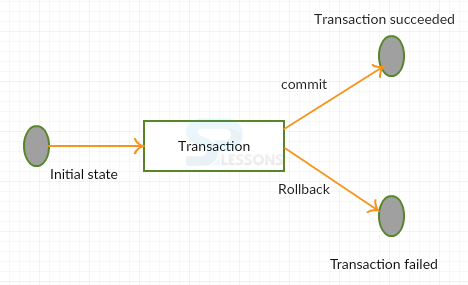 Description
Description
Spring Transaction Management, Before Spring exchange, EJB was an effective API accessible offering bean managed and holder managed exchanges. A database exchange speaks to a solitary unit of work. The idea of exchanges can be depicted as ACID properties as follows.
- Atomicity : In an exchange including two or more discrete bits of data, it is possible that the majority of the pieces are conferred or none are(all or nothing).
- Consistency : An exchange either makes another and legitimate condition of information, or, if any failure happens, gives back all information to its state before the exchange was begun(results are valid).
- Isolation : A transaction in procedure and not yet committed must remain isolated from some other transaction.
- Durability : Submitted information is saved by the system such that, even in the case of a failure and system restart, the information is accessible in its right state.
 Description
Description
The Spring transaction advantage is it gives programmatic and declarative exchange management.
Programmatic transaction management gives exact control on the limits of the exchange.Example as follows.
[java]onlineBooking(){
T1.start();
checkAvailability();
T1.Commit();
T2.start();
selectItems();
payment();
itemConfirmation();
T2.commit();
}[/java]
 Description
Description
Declarative transactions are less intrusive and are characterized in a configuration document.Spring underpins it via AOP .It created in view of the AOP ideas. This gives an utilization of keeping the cross cutting concerns like exchanges of DAO layer code.
 Description
Description
TransactionDefinition defined as below:
[java]public interface TransactionDefinition {
int getPropagationBehavior();
int getIsolationLevel();
String getName();
int getTimeout();
boolean isReadOnly();
}[/java]
Conceivable values for Isolation levels are as per the following
Possible values for propagation types are as follows:
| Methods | Description |
|---|---|
| int getPropagationBehavior() | It returns the propagation behavior.Spring offers the majority of the exchange propagation choices different from EJB CMT. |
| int getIsolationLevel() | It gives back the extent to which this exchange is segregated from the work of different exchanges. |
| string getName() | It returns the title of exchange. |
| int getTimeout() | The transaction should complete while returns the time in seconds . |
| boolean isReadOnly() | If exchange is readable then it returns. |
| Isolation | Description |
|---|---|
| TransactionDefinition.ISOLATION_DEFAULT | It is specific to the data source. |
| TransactionDefinition.ISOLATION_READ_COMMITTED | Shows that filthy peruses are anticipated; non-repeatable peruses and ghost peruses can happen. |
| TransactionDefinition.ISOLATION_READ_UNCOMMITTED | Demonstrates that filthy peruses, non-repeatable peruses and apparition peruses can happen. |
| TransactionDefinition.ISOLATION_REPEATABLE_READ | Demonstrates that filthy peruses and non-repeatable peruses are avoided; ghost peruses can happen. |
| TransactionDefinition.ISOLATION_SERIALIZE | Demonstrates that messy peruses, non-repeatable peruses and ghost peruses are averted. |
| Propagation | Description |
|---|---|
| TransactionDefinition.PROPAGATION_MANDATORY | Method ought to keep running in an exchange and nothing exists-exception will be thrown. |
| TransactionDefinition.PROPAGATION_NESTED | METHOD ought to keep running in a nested exchange |
| TransactionDefinition.PROPAGATION_NEVER | Current method ought not keep running in a transaction.If exists an exception will be thrown. |
| TransactionDefinition.PROPAGATION_NOT_SUPPORTED | Method ought not keep running in a transaction.existing exchange will be suspended till method finishes the execution. |
| TransactionDefinition.PROPAGATION_REQUIRED | Method ought to keep running in a transaction.If already exists,method will keep running in that and if not,a new transaction will be made. |
| TransactionDefinition.PROPAGATION_REQUIRES_NEW | Create a new transaction, suspending the present transaction if one exists. |
| TransactionDefinition.PROPAGATION_SUPPORTS | Method ought to keep running in another transaction.If already exists,it will be suspended till the method wraps up. |
 Key Points
Key Points
- Spring Transaction Management - Spring transaction no need of using JTA.
- Spring Transaction Management - Spring transactions are good at applications by preferring single database.
- Spring Transaction Management - Spring underpins declarative exchange management through the AOP .




